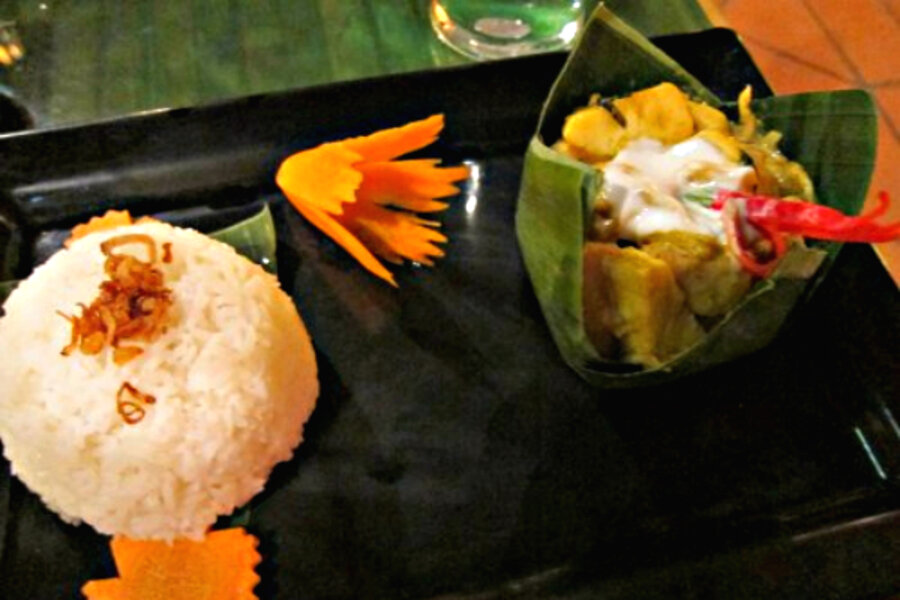Travel: Amok fish in Cambodia
Loading...
Our first day in Cambodia began with a row of uniformed customs officials, splendid and unsmiling and endless. They collected visa fees and photos and scrutinized and stamped and handed passports up the line while I shifted from foot to foot with excitement and tried to look like the sort of person who should definitely be given her passport back and admitted to their country.
The town of Siem Reap was an intoxicating jumble of extremes: the sun, the dust, the humidity, the sense that an encroaching jungle might just take back this crumbling mix of faded colonial architecture and humble shacks at any moment.
After sunset, the heat still washed over us in waves like steam rolling from a shower. The smell of dust and exhaust fumes still filled the air. But without the remorseless tropical sunshine beating down, we were able to leave the pool and venture out of our hotel, to find the streets even livelier after dark. The town pulsed with life. Traffic whizzed by like a slow river without regard for lanes – a blur of scooters carrying entire families, tuk-tuks, and a few cars – horns honking and voices calling out. People filled the narrow sidewalks, some slowly walked, but more stood clustered around open shop fronts, or waited for their turn at open-air food stands.
“Tuk-tuk?” “Tuk-tuk?” chanted the drivers as we passed, reclining in the back of their own motorcycle trailers as they waited for fares.
We dodged and scurried to cross the street, sighing with relief upon reaching safe harbor on the opposite side.
Pub Street pulsed with life. We strolled past the open-fronted restaurants and bars that lined the streets, filled with travelers from everywhere, speaking every language. I glanced into stores that sold everything from souvenirs to sandals. A few street performers set up on corners, and a few children selling trinkets sidled near the outermost restaurant tables.
After wandering down a relatively quiet pedestrian side-street, we settled into chairs outside a restaurant called Le Tigre de Papier. A lean cat passed under tables, brushing ankles, hoping for a handout, then he rolled on the dusty pavement, coming to a rest by my foot.
As we perused the menu, the heat pressed against me like a giant restraining hand – utterly enveloping, preventing hasty movement, but increasingly comfortable as I slowed my breathing and relaxed into its velvety embrace.
Slowly, we ate amok fish from bowls made, origami-style, from banana leaves, with steamed rice on the side. The flavor of this dish was rich, complex, slightly sweet, and similar to a very mild yellow curry – full of spices, but not hot and spicy.
After scraping our plates clean, we leaned back in our chairs, relax, and watched the city night life pass by. The key to Siem Reap seems to be in its pace – it is a vibrant town, but not a town that is in a hurry. People – locals, expats, travelers – move without haste, talk without pressure, and have time for a drink or a meal, time for a conversation and a smile.
Amok dishes (usually fish, but also chicken or shrimp) were on every menu in Siem Reap. And while no vacation meal recreated at home will taste quite the same – lacking, as it must, that vital something imparted by context – it is possible to produce a creditable and tasty replica.
Should you not be able to track down a pre-made amok spice blend, try creating your own approximation by combining roughly equal parts chopped lemon grass, kaffir lime zest, galangal, turmeric, garlic, and dried red chile flakes and pulverize in food processor. These ingredients are readily available in most Asian grocery stores.
Amok Fish
2 tablespoons amok spices
2 teaspoons sugar
1/2 teaspoon salt
2 tablespoons fish sauce or soy sauce
1 tablespoon garlic (crushed)
2 tablespoons shallots, minced
15 ounces coconut milk
1 lb. firm fish fillets, such as snapper, tilapia, or catfish, cut into chunks
4 banana leaves (or substitute collard or other sturdy greens)
Mix amok spices, sugar, salt, fish sauce, garlic, shallots, and coconut milk. Submerge fish fillets in mixture, cover, and let sit in refrigerator for 15 minutes.
Meanwhile, assemble banana leaf boats (here is a short but amusing how-to video, or use your own origami skills). Alternately, you could simply line four small ramekins with banana leaves.
Fill banana leaf boats (or ramekins) with fish mixture and place in steamer. Steam for about 30 minutes, or until fish is cooked through and very tender.
Serve with steamed rice.
Related post on The Rowdy Chowgirl: Breakfast at Angkor Wat









